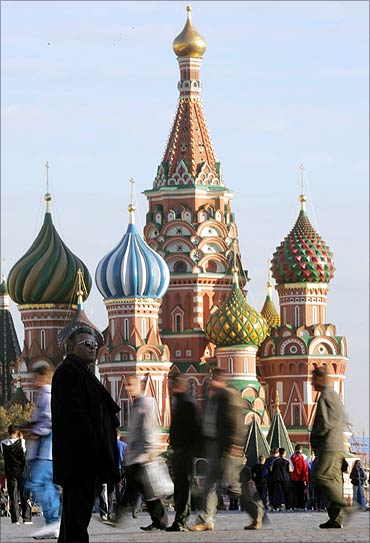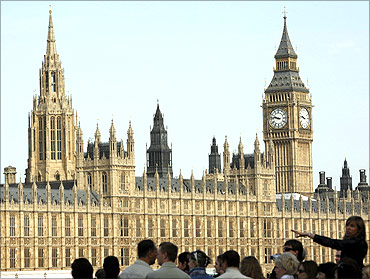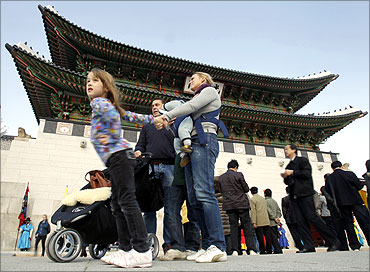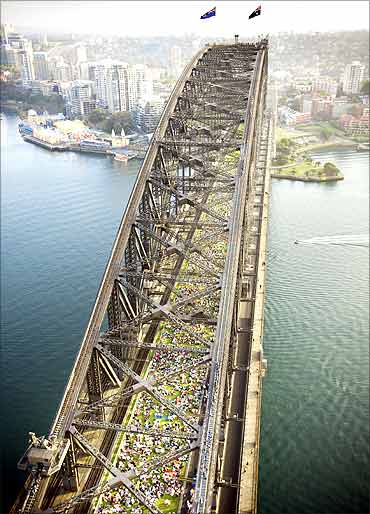 | « Back to article | Print this article |
World's 20 largest economies
The United States' reign as the world's largest economy will end in less than a decade. China is all set to surge ahead as the world's biggest economy. So say the gurus of economics.
The growth story gets more interesting with India poised to become the world's largest economy by 2050 pushing china to the second place.
India's working age population will rise more than 40 per cent in the next forty years making it a real economic superpower.
Global economic power will be more balanced between developed and developing economies. By 2020 with China, the USA and India the three largest economies in the world in PPP terms.
As the world's leading economies face uncertain times, their rankings in terms of GDP will also change in the years to come.
Click NEXT to find out more about the world's 20 largest economies...
World's 20 largest economies
1. United States
GDP (PPP): $15.065 trillion (2011 estimate)
The United States has a capitalist mixed economy with a well-developed infrastructure.
According to the International Monetary Fund, the US GDP constitutes 23 per cent of the gross world product at market exchange rates and over 20 per cent of the gross world product at purchasing power parity (PPP).
From 1947 to 2011 the United States' average quarterly GDP growth was 3.28 per cent reaching a high of 17.20 per cent in March 1950 and a low of -10.40 per cent in March 1958.
The US economy is facing a crisis again. The Federal Reserve has cut the country's economic growth forecast for the second time this year, reducing its estimate of 2011 gross domestic product growth to a range of 2.7- 2.9 per cent.
Click NEXT to read more...
World's 20 largest economies
2. China
GDP (PPP): $11.316 trillion (2011 estimate)
China, the world's most populous nations has been the world's fastest-growing major economy, with consistent growth rates of around 10 per cent over the last three decades.
China is also the largest exporter and second largest importer of goods in the world.
Even as China has registered a faster growth than Western nations, it eased slightly for the second quarter in a row.
China's economy grew at an annual pace of 9.5 per cent between April and June.
Click NEXT to read more...
World's 20 largest economies
3. Japan
GDP (PPP): $4.396 trillion (2011 estimate)
Japan has an efficient and competitive economy. It GDP contracted by 0.50 per cent in the second quarter of 2011 over the previous quarter.
Japan's average quarterly GDP growth was 0.52 percent from 1980 until 2011, hitting a high of 3.15 per cent in June 1990 and a record low of -4.90 percent in March of 2009.
Japan established itself as the world's second largest economy from 1968 till 2010, when it was surpassed by China.
Click NEXT to read more...
World's 20 largest economies
4. India
GDP (PPP): $4.060 trillion (2011 estimate)
India's economy grew by 7.7 per cent in three months from April to June, compared with the same period of 2010.
During 2007-08, India's GDP recorded a growth of 9.1 per cent, turning it into one of the fastest growing economies of the world.
According to Goldman Sachs, by 2020 India's gross domestic product would be four times of what it was in 2007.
Click NEXT to read more...
World's 20 largest economies
5. Germany
GDP (PPP): $3.089 trillion (2011 estimate)
Germany is the largest national economy in Europe, the fourth-largest by nominal GDP in the world, and fifth by GDP (PPP).
Germany is the world's second largest exporter. Its GDP grew by 0.1 per cent in the second quarter of 2011 over the previous quarter.
Germany's average quarterly GDP growth was 0.31 per cent from 1991 till 2011, hitting a high of 2.10 per cent in June 2010 and a record low of -3.70 per cent in March 2009.
Click NEXT to read more...
World's 20 largest economies
6. Russia
GDP (PPP): $2.223 trillion (2011 estimate)
Russia has the world's 11th largest economy by nominal GDP and the 6th largest by purchasing power parity
Russia's GDP grew by 1.10 per cent in the first quarter of 2011 over the previous quarter.
Russia's average quarterly GDP growth was 1.22 per cent from 2003 until 2011, hitting a high of 3.20 per cent in December of 2006 and a low of -4.20 per cent in December 2008.
Click NEXT to read more...
World's 20 largest economies
7. United Kingdom
GDP (PPP): $2.173 trillion (2011 estimate)
One of the world's most developed economies, United Kingdom has the sixth-largest national economy in the world by nominal GDP and seventh-largest in terms of purchasing power parity (PPP).
It is third-largest economy in Europe measured by nominal GDP (after Germany and France).
United Kingdom's GDP grew by 0.10 per cent in the second quarter of 2011 over the previous quarter.
From1955 till 2011, United Kingdom's average quarterly GDP growth was 0.58 per cent reaching a high of 5.30 per cent in March 1973 and a low of -2.50 per cent in March 1974.
Click NEXT to read more...
World's 20 largest economies
8. Brazil
GDP (PPP): $2.172 trillion (2011 estimate)
Brazil has one of the world's fastest growing economies. The Brazilian economy is the world's seventh largest economy by nominal GDP and the eighth largest by purchasing power parity.
Brazil is also the largest national economy in Latin America, the world's seventh largest economy at market exchange rates and the eighth largest in purchasing power parity (PPP), according to the International Monetary Fund and the World Bank.
The Brazilian economy is set to become one of the five largest economies in the world.
Click NEXT to read more...
World's 20 largest economies
9. France
GDP (PPP): $2.145 trillion (2011 estimate)
France is one of the world's most developed countries. It is Europe's second largest economy by nominal GDP.
France is the wealthiest European nation and enjoys a high standard of living.
The Gross Domestic Product (GDP) in France dropped in the second quarter of 2011.
France's quarterly GDP growth was 0.48 per cent from 1978 till 2011, reaching a high of 1.60 percent in June of 1978 and a record low of -1.60 percent in December of 2008.
Click NEXT to read more...
World's 20 largest economies
10. Italy
GDP (PPP): $1.773 trillion (2011 estimate)
Italy has been ranked the world's 23rd most-developed country and its quality-of-life has been ranked in the top ten in the world.
Italy enjoys a very high standard of living and has the world's eighth-largest nominal GDP, tenth highest GDP (PPP) and the sixth highest government budget in the world.
Italy's GDP rose 0.30 per cent in the second quarter of 2011. Italy's average quarterly GDP growth was 0.35 per cent from 1981 to 2011, hitting a high of 2.20 percent in December of 1983 and a record low of -3.00 per cent in March 2009.
Click NEXT to read more...
World's 20 largest economies
11. Mexico
GDP (PPP): $1.629 trillion (2011 estimate)
A newly industrialised nation, Mexico has the thirteenth largest nominal GDP and the eleventh largest by purchasing power parity.
According to Goldman Sachs, Mexico will have the 5th largest economy in the world by 2050.
Mexico's GDP rose 1.1 per cent in the second quarter of 2011 over the previous quarter.
Mexico's average quarterly GDP growth was 0.64 per cent from 1993 till 2011 rising to a high of 2.90 per cent in March 1996 and a low of -7.00 per cent in March 2009.
Click NEXT to read more...
World's 20 largest economies
12. South Korea
GDP (PPP): $1.459 trillion (2011 estimate)
South Korea has recorded high growth and transformed into a high-tech modern world economy.
South Korea's GDP grew by 0.80 percent in the second quarter of 2011.
The country's average quarterly GDP growth was 1.78 per cent from 1970 to 2011 reaching an high of 6.80 per cent in March 1988 and a record low of -7.00 per cent in March 1998.
Click NEXT to read more...
World's 20 largest economies
13. Spain
GDP (PPP): $1.395 trillion (2011 estimate)
Spain has the twelfth-largest economy in the world, based on nominal GDP and the fifth-largest in Europe.
Spain's GDP rose 0.20 per cent in the second quarter of 2011 over the previous quarter.
Spain's average quarterly GDP growth was 0.65 per cent from 1995 to 2011, reaching a high of 1.53 percent in December 1997 and a record low of -1.60 per cent in March 2009.
Click NEXT to read more...
World's 20 largest economies
14. Canada
GDP (PPP): $1.33 trillion (2011 estimate)
Canada has the ninth largest economy in the world. It is also one of the world's wealthiest nations.
Canada's GDP fell 0.1 percent in the second quarter of 2011 over the previous quarter.
The country's average quarterly GDP growth was 0.84 percent from 1961 until 2011 hitting a high of 3.33 per cent in December 1963 and a low of -1.80 per cent in March 2009.
Click NEXT to read more...
World's 20 largest economies
15. Indonesia
GDP (PPP): $1.139 trillion (2011 estimate)
Indonesia is the largest economy in Southeast Asia and is one of the emerging market economies of the world.
Indonesia's GDP rose 2.90 percent in the second quarter of 2011.
The country's average quarterly GDP growth was 1.50 per cent from 2005 to 2011 reaching an historical high of 3.82 per cent in September 2009 and a record low of -3.57 percent in December 2008.
Click NEXT to read more...
World's 20 largest economies
16. Turkey
GDP (PPP): $1.116 trillion (2011 estimate)
Turkey has a developing economy. Turkey's GDP rose 1.3 per cent in the second quarter of 2011 over the previous quarter.
The country's average quarterly GDP growth was 0.95 per cent hitting a high of 6.69 per cent in June 2009 and a record low of -7.57 per cent in March 2009.
Click NEXT to read more...
World's 20 largest economies
17. Iran
GDP (PPP): $882.362 billion (2011 estimate)
Iran is the 17th largest economy in the world by purchasing power parity (PPP). It is poised to become the 12th largest economy by 2015.
Iran is one of the few major economies that achieved positive growth after the 2008 global financial crisis.
Click NEXT to read more...
World's 20 largest economies
18. Australia
GDP (PPP): $863.5 billion (2011 estimate)
Australia has a developed and modern market economy.
Australia's GDP expanded 1.20 per cent in the second quarter of 2011 over the previous quarter.
The country's average quarterly growth was 0.89 per cent from 1959 until 2011 hitting a high of 4.60 per cent in March 1976 and a record low of -2.70 per cent in June 1974.
Click NEXT to read more...
World's 20 largest economies
19. Taiwan
GDP (PPP): $824.67 billion (2011 estimate)
One of the fastest growing economies in Asia, Taiwan's GDP rose 0.23 per cent in the second quarter of 2011.
Taiwan's average quarterly GDP growth was 1.43 per cent from 1981 until 2011 hitting a historical high of 5.64 per cent in December 1990 and a record low of -5.07 per cent in December 2008.
Click NEXT to read more...
World's 20 largest economies
20. Poland
GDP (PPP): $754.097 billion (2011 estimate)
Poland has the sixth largest economy in the EU. One of the fastest growing economies in Europe, Poland's GDP rose by 1.1 per cent in the second quarter of 2011.
Poland's average quarterly GDP growth was 1.11 per cent from 1995 until 2011reaching a high of 6.40 per cent in March 1997 and a low of -3.20 per cent in December 1996.




















